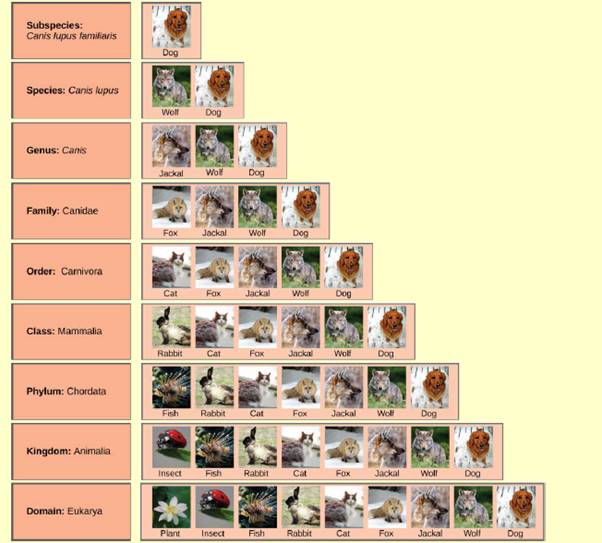
Concept explainers
Figure 12.3 In what levels are cats and dogs considered to be part of the same group?


To determine:
The levels in which the cats and dogs are considered to be the part of same group.
Introduction:
The hierarchical system classifies the various species into the groups. Such system is also termed as the taxonomic classification, as each level as termed taxa here. Broadly the organism is classified in kingdom and domain. The genus and the species name are the most accurate classification.
Explanation of Solution
The scientific name of the cat is Felis catus which belongs to the family Felidae. They are domestic cats. The classification of the cat is as below:
Kingdom − Animalia (It is composed of multicellular eukaryotic animals.)
Phylum − Chordata (The organisms that contain notochord, dorsal nerve cord, pharyngeal slits, an endostyle, and a post-anal tail during any period of their life cycle.)
Class − Mammalia (The vertebrate animals compose this class.)
Order − Carnivora (It is composed of meat-eating animals.)
Suborder − Feliformia (It contains the cat-like carnivores.)
Family − Felidae (This family mainly consists of cats only.)
Subfamily − Felinae (This subfamily is comprised of small cats. These cats do not roar but are able to purr.)
The scientific name of the dog is Canis lupus familiaris. It is basically the domestic dog. The scientific classification of the dog is as follow:
Kingdom − Animalia
Phylum − Chordata
Class − Mammalia
Order − Carnivora
Family − Canidae (This family consists of domestic dogs, wolves, coyotes, foxes, jackals, and others.)
The cats and the dogs belong to the kingdom Animalia, phylum Chordata, class Mammalia, and order Carnivora. This means that both dogs and cats are multicellular animals, that contained notochord and other differential structures during their lifetime. Moreover, they are vertebrate and are carnivorous animals.
The cats and the dogs are similar at the levels of kingdom, phylum, class, and order.
Want to see more full solutions like this?
Chapter 12 Solutions
Concepts of Biology
Additional Science Textbook Solutions
Biology: Life on Earth (11th Edition)
Genetic Analysis: An Integrated Approach (3rd Edition)
Microbiology: An Introduction
Applications and Investigations in Earth Science (9th Edition)
Biological Science (6th Edition)
Concepts of Genetics (12th Edition)
- Selection of Traits What adaptations do scavengers have for locating and feeding on prey? What adaptations do predators have for capturing and consuming prey?arrow_forwardCompetition Between Species What natural processes limit populations from growing too large? What are some resources organisms can compete over in their natural habitat?arrow_forwardSpecies Interactions Explain how predators, prey and scavengers interact. Explain whether predators and scavengers are necessary or beneficial for an ecosystem.arrow_forward
- magine that you are conducting research on fruit type and seed dispersal. You submitted a paper to a peer-reviewed journal that addresses the factors that impact fruit type and seed dispersal mechanisms in plants of Central America. The editor of the journal communicates that your paper may be published if you make ‘minor revisions’ to the document. Describe two characteristics that you would expect in seeds that are dispersed by the wind. Contrast this with what you would expect for seeds that are gathered, buried or eaten by animals, and explain why they are different. (Editor’s note: Providing this information in your discussion will help readers to consider the significance of the research).arrow_forwardWhat is the difference between Uniporters, Symporters and Antiporters? Which of these are examples of active transport?arrow_forwardWhat are coupled transporters?arrow_forward
- How do histamine and prostaglandins help in the mobilization of leukocytes to an injury site? What are chemotactic factors? How do they affect inflammation process?arrow_forwardCompare and contrast neutrophils and macrophages. Describe two ways they are different and two ways they are similar.arrow_forwardDescribe the effects of three cytokines (not involved in the initial inflammation response). What cells release them?arrow_forward
 Concepts of BiologyBiologyISBN:9781938168116Author:Samantha Fowler, Rebecca Roush, James WisePublisher:OpenStax College
Concepts of BiologyBiologyISBN:9781938168116Author:Samantha Fowler, Rebecca Roush, James WisePublisher:OpenStax College Biology 2eBiologyISBN:9781947172517Author:Matthew Douglas, Jung Choi, Mary Ann ClarkPublisher:OpenStax
Biology 2eBiologyISBN:9781947172517Author:Matthew Douglas, Jung Choi, Mary Ann ClarkPublisher:OpenStax


